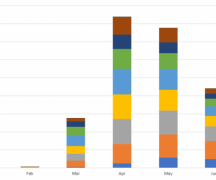By Susan Tebben
Democratic legislators are leading the charge to raise the minimum wage in the state after a federal effort failed.
State. Sen. Hearcel Craig and Sen. Cecil Thomas presented the bill in Senate Workforce and Higher Education recently, proposing increasing wages to $15 an hour by 2025.
“Raising the minimum wage to $15 by 2025 would give 2 million Ohioans a raise that is long overdue while allowing people to lift themselves out of poverty,” Craig said.
Ohio’s minimum wage stands at $8.80 per hour, and $4.40 per hour for tipped workers.
The new bill would raise the minimum to $12 on Jan. 1, 2022, and have an annual $1 increase until 2025. Tipped workers would move up to $7.50 hourly by 2025.
U.S. legislators took up the same issue in debates over the $1.9 billion stimulus bill that recently passed. While other funding elements passed, like $1,400 checks for many Americans, the minimum wage issue was dropped.
The minimum wage issue continues on the federal side, though it’s unclear whether it will succeed. U.S. Sen. Rob Portman, R-Ohio, was among five federal legislators introducing a minimum wage raise of $10 per hour, which also included a mandate that electronic verification be used “to ensure the wage increase only goes to legal workers,” according to a press release from Portman’s office.
Ohio Democratic U.S. Sen. Sherrod Brown supports a $15 an hour minimum wage, and said so as the Senate debated the stimulus bill.
“We will find a way to increase wages,” Brown said. “I don’t think voters care about all the inner machinations going on in Congress. I don’t think they care how we do it.”
A study by the Economic Policy Institute showed that having $15 per hour minimum wage by 2025 would impact poverty in terms of tax credits and federal assistance programs. The study estimated a drop in public assistance programs between $13.4 and $31 billion.
“These large wage increases would disproportionately raise the incomes of families at the bottom of the income distribution and would meaningfully reduce the number of families in poverty,” the EPI study stated.
Money spent on the Supplemental Nutrition Assistance Program (SNAP) would drop by $5.2 billion and $10.3 per year, according to the EPI study.
The Ohio bill currently only has Democratic cosponsors signed on, and with a Republican supermajority in Ohio legislature, they will need to garner bipartisan support for the bill to become law.
***
How much should Ohio invest in public transportation? Advocates make case for more funding
Advocates are urging lawmakers to invest more money into Ohio’s public transportation systems and commit to long-term support for this transit spending.
Gov. Mike DeWine presented deep cuts to public transportation in his proposed budget. The Ohio House of Representatives restored much of the funding in its transportation budget passed earlier in March.
But this “semi course correction,” as Policy Matters Ohio senior researcher Amanda Woodrum puts it, is still less than what was allocated in the last two-year transportation budget passed in 2019. And it remains a far cry from the amount transportation advocates and experts say is necessary to properly fund transportation opportunities for Ohioans.
Attention now turns to the Ohio Senate, whose members are debating the transportation budget. Legislators have a March 31 deadline for having this budget be fully approved.
Public transportation in Ohio is funded through a number of local, state and federal sources. In recent committee hearings, those representing transit systems in big cities and small told of the need for adequate state funding in their communities. READ MORE
Will state Medicaid reforms prove we were getting a bad deal?
The Ohio Department of Medicaid in January implemented a massive overhaul to the way it administers prescription drug benefits to more than a quarter of all Ohioans. Now, the department is hiring its own middleman to handle the transactions.
The department expects to save $128 million during the fiscal year starting July 1 and $184 million the year after that.
That raises an important question: Were the Ohio and federal taxpayers who fund Medicaid getting ripped off under the earlier arrangement, under which the state’s five managed-care plans hired their own middlemen? It’s a debate that’s raged since early 2018 and not too many months may have to pass before we have an answer. READ MORE
Ohio on track to meet Biden push to make all adults eligible for COVID-19 vaccines by May 1
WASHINGTON — President Joe Biden is directing states to make all adults eligible for the COVID-19 vaccine by May 1, and Ohio Gov. Mike DeWine said over the weekend the state is on track to do that or better.
Biden’s COVID-19 advisers are projecting that enough Americans in priority groups will be able to access the vaccine by the end of April to allow for the lifting of restrictions on who can access the vaccine.
Alaska on Tuesday became the first state to open eligibility to anyone age 16 or older.
The announcement came Thursday on the one-year anniversary of the World Health Organization declaring the COVID-19 outbreak to be a pandemic.
Earlier on Thursday, Biden signed into law a massive pandemic stimulus bill that includes $20 billion to boost vaccination efforts across the country.
He also announced Wednesday that his administration secured another 100 million of the one-dose Johnson & Johnson vaccine, after helping to broker a deal in which Johnson & Johnson will team up with drugmaker Merck to produce doses faster. READ MORE





